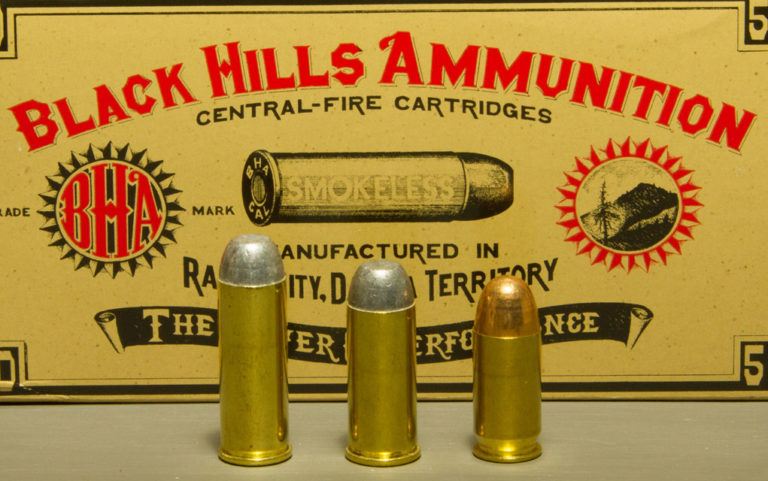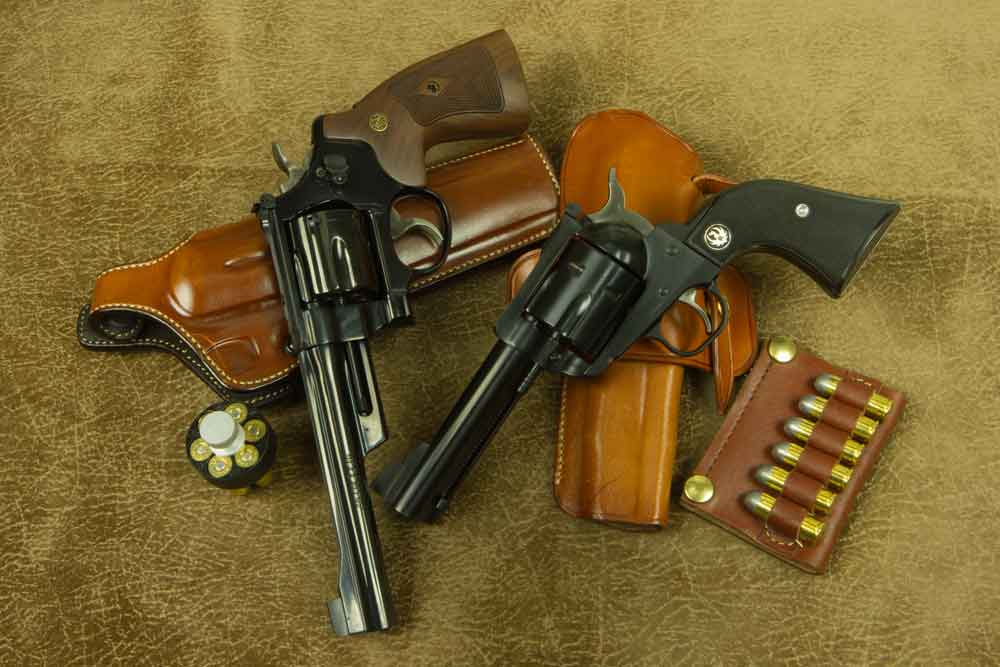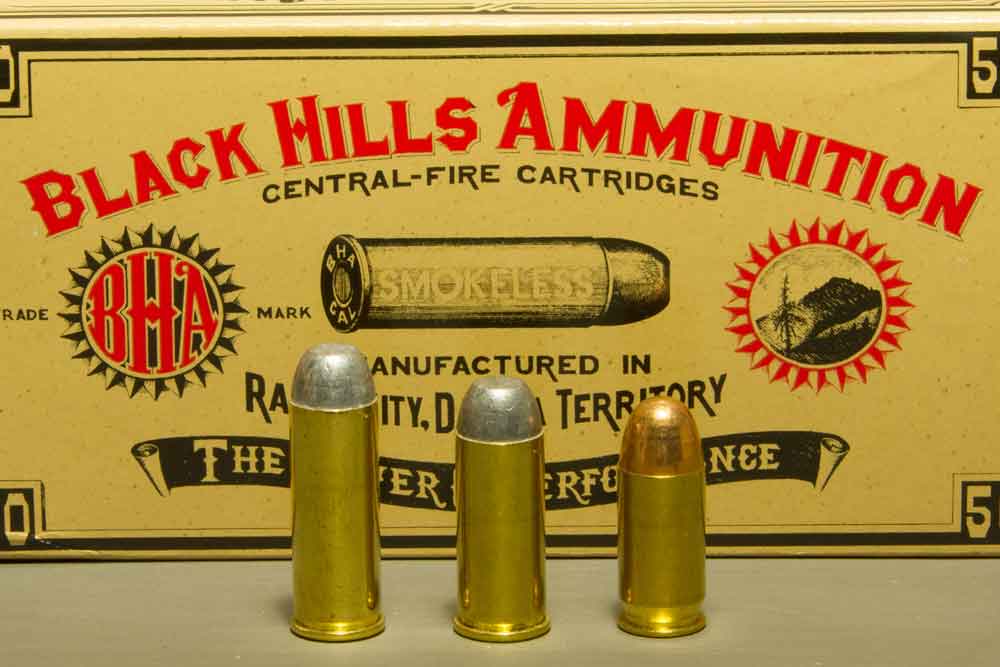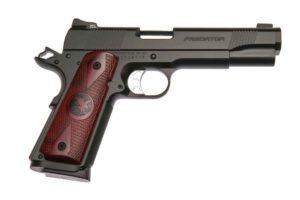
The U.S. has had a love of the .45-caliber cartridge for many years. Nowhere is this more apparent than in the enduring popularity of the .45 ACP, and its earlier predecessor, the .45 Colt.
How did the .45 Auto, or .45 ACP, cartridge come into being?
- The U.S. adopted the .45 Colt in 1873, pairing it with Colt's Single Action Army revolver.
- It served for almost two decades before replacement by the .38 Long Colt.
- Complaints were made during the Phillipine Insurrection about the .38's stopping power.
- The .45 Colt was reissued, and it remained in service until the .45 ACP's adoption.
- The .45 ACP was adopted in Browning's M1911.
- However, it first saw action in World War I in a double-action revolver.
To celebrate the .45-caliber handgun cartridge, a group of writers recently met at Gunsite Academy to experience shooting semi-automatics, and single-action and double-action revolvers all chambered in .45.
 Contact range to long-range shooting and training was conducted using a Ruger New Blackhawk single-action revolver, a Smith & Wesson Model 25 Classic double-action revolver with Pachmayr Decelerator Grips — both in .45 Colt — and a Nighthawk Custom 1911 chambered in .45 ACP. Black Hills supplied ammunition, and Galco provided holsters. Everything worked flawlessly, with each gun representing a step in the evolution of the .45.
Contact range to long-range shooting and training was conducted using a Ruger New Blackhawk single-action revolver, a Smith & Wesson Model 25 Classic double-action revolver with Pachmayr Decelerator Grips — both in .45 Colt — and a Nighthawk Custom 1911 chambered in .45 ACP. Black Hills supplied ammunition, and Galco provided holsters. Everything worked flawlessly, with each gun representing a step in the evolution of the .45.
In 1873 the U.S. Government adopted the .45 Colt cartridge for its new standard sidearm, the Single Action Army revolver. It fired a 250-grain lead bullet that left the muzzle at about 900 feet per second (fps), making it a powerful handgun round that soon gained a good reputation for protection.
 For nearly two decades, the Single Action Army in its .45-caliber chambering remained the official government sidearm, but about 1890 it was replaced with a revolver chambered in .38 Long Colt. The new cartridge proved to be inadequate though for stopping Moro fighters during the Philippine Insurrection, so the 1873 Single Action Army revolver chambered in .45 Colt was quickly reissued. The .45 Colt cartridge remained in government use then until John Browning’s M1911 that chambered the .45 ACP was adopted in 1911.
For nearly two decades, the Single Action Army in its .45-caliber chambering remained the official government sidearm, but about 1890 it was replaced with a revolver chambered in .38 Long Colt. The new cartridge proved to be inadequate though for stopping Moro fighters during the Philippine Insurrection, so the 1873 Single Action Army revolver chambered in .45 Colt was quickly reissued. The .45 Colt cartridge remained in government use then until John Browning’s M1911 that chambered the .45 ACP was adopted in 1911.
 Even though the government had adopted the semi-auto 1911, a double-action revolver chambered in .45 ACP was pressed into use during World War I. At Gunsite, the M25 Classic represented this class of guns, although it was not one that was used during WWI.
Even though the government had adopted the semi-auto 1911, a double-action revolver chambered in .45 ACP was pressed into use during World War I. At Gunsite, the M25 Classic represented this class of guns, although it was not one that was used during WWI.
The .45 Colt and the .45 ACP have about the same ballistics, so the .45 could be called “America’s handgun caliber.” It has served our military, police and law-abiding citizens well for more than a century, and, to some people, challenging its supremacy is heresy.
Editor's Note: This article is an excerpt from the September 2017 issue of Gun Digest the Magazine.

Next Step: Get your FREE Printable Target Pack
Enhance your shooting precision with our 62 MOA Targets, perfect for rifles and handguns. Crafted in collaboration with Storm Tactical for accuracy and versatility.
Subscribe to the Gun Digest email newsletter and get your downloadable target pack sent straight to your inbox. Stay updated with the latest firearms info in the industry.

![Best Concealed Carry Guns In 2025 [Field Tested] Wilson Combat EDC X9S 1](https://gundigest.com/wp-content/uploads/Wilson-Combat-EDC-X9S-1-324x160.jpg)


![Best 9mm Carbine: Affordable PCCs [Tested] Ruger Carbine Shooting](https://gundigest.com/wp-content/uploads/Ruger-Carbine-Shooting-100x70.jpg)
![Best AR-15: Top Options Available Today [Field Tested] Harrington and Richardson PSA XM177E2 feature](https://gundigest.com/wp-content/uploads/Harrington-and-Richardson-PSA-XM177E2-feature-100x70.jpg)

I have to concur. .45 caliber is a fine caliber for designing a defensive round. The .45 ACP comes in both semi-automatic and double action revolver fashion and either way is a long-established round suitable for personal defense in either professional (job) or personal role.
The .45 Colt is also a fine round, suffering only from being slightly less controllable due to slightly higher recoil, and the cartridge was designed as a black powder design, requiring a larger case than needed with smokeless powder.